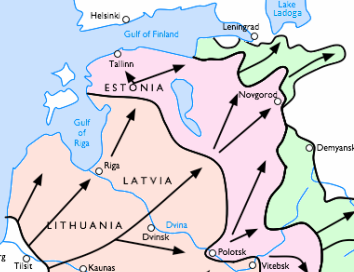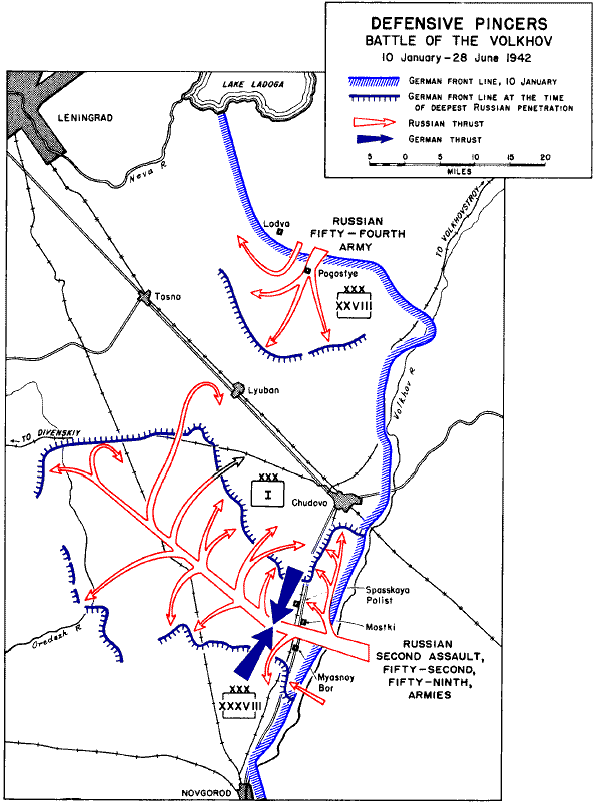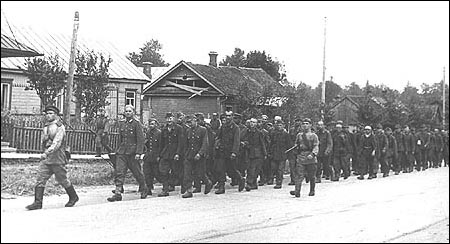|
Mga Offensive
The Mga offensive or Third Battle of Lake Ladoga () or fifth Sinyavino offensive was an unsuccessful offensive operation by Soviet troops between 22 July and 25 September 1943 to break the siege of Leningrad. Prelude Leningrad had been surrounded since 8 September 1941. The Soviets had launched several counterattacks in 1941, 1942 and most recently in Spring 1943 with the failed Operation Polar Star. The only success so far had been achieved in January 1943, when during Operation Iskra, a land corridor was opened between Leningrad and the rest of the Soviet Union. However, the land corridor remained within range of German artillery on the Sinyavino Heights, and the Red Army planned a new attack for July 1943. The attack was to be carried out by the 8th Army (Filipp Starikov) of the Volkhov Front (Kirill Meretskov) and the 67th Army ( Mikhail Dukhanov) of the Leningrad Front (Leonid Govorov) against the troops of the German 18th Army (Georg Lindemann) of Army Group North ... [...More Info...] [...Related Items...] OR: [Wikipedia] [Google] [Baidu] |
Eastern Front (World War II)
The Eastern Front, also known as the Great Patriotic War (term), Great Patriotic War in the Soviet Union and its successor states, and the German–Soviet War in modern Germany and Ukraine, was a Theater (warfare), theatre of World War II fought between the European Axis powers and Allies of World War II, Allies, including the Soviet Union (USSR) and Polish Armed Forces in the East, Poland. It encompassed Central Europe, Eastern Europe, Northern Europe, Northeast Europe (Baltic states, Baltics), and Southeast Europe (Balkans), and lasted from 22 June 1941 to 9 May 1945. Of the estimated World War II casualties, 70–85 million deaths attributed to World War II, around 30 million occurred on the Eastern Front, including 9 million children. The Eastern Front was decisive in determining the outcome in the European theatre of World War II, European theatre of operations in World War II, eventually serving as the main reason for the defeat of Nazi Germany and the Axis ... [...More Info...] [...Related Items...] OR: [Wikipedia] [Google] [Baidu] |
Siege Of Leningrad
The siege of Leningrad was a Siege, military blockade undertaken by the Axis powers against the city of Leningrad (present-day Saint Petersburg) in the Soviet Union on the Eastern Front (World War II), Eastern Front of World War II from 1941 to 1944. Leningrad, the country's second largest city, was besieged by Nazi Germany, Germany and Finland for 872 days, but never captured. The siege was the List of sieges, most destructive in history and possibly the List of battles by casualties#Sieges and urban combat, most deadly, causing an estimated 1.5 million deaths, from a prewar population of 3.2 million. It was not classified as a war crime at the time, but some historians have since classified it as a genocide due to the intentional destruction of the city and the systematic starvation of its civilian population. p. 334 In August 1941, Nazi Germany, Germany's Army Group North reached the suburbs of Leningrad as Finnish forces moved to encircle the city from the north. Land ... [...More Info...] [...Related Items...] OR: [Wikipedia] [Google] [Baidu] |
126th Infantry Division (Wehrmacht)
The 126th Infantry Division () was a German division in World War II. It was formed on 18 October 1940 in Sennelager. The division was formed from elements of the 11th Infantry Division, 253rd Infantry Division and the non-motorized elements of the 16th Motorized Infantry Division. It fought at Demyansk, Staraya Russia and Leningrad before ending the war in the Courland Pocket. Commmanders * General der Infanterie Paul Laux (5 October 1940 – 10 October 1942) * Generalleutnant Harry Hoppe (10 October 1942 – 31 April 1943) * Generalleutnant Friedrich Hofmann (31 April 1943 – 8 July 1943) * Generalleutnant Harry Hoppe (8 July 1943 – 7 November 1943) * Generalleutnant Gotthard Fischer (7 November 1943 – 5 January 1945) * Generalmajor Kurt Hähling (5 January 1945 – 8 May 1945) Order of battle 1940 * Infantry Regiment 422 * Infantry Regiment 424 * Infantry Regiment 426 * Artillery Regiment 126 * Divisions Units 126 1943 * Grenadier Regiment 422 * Grena ... [...More Info...] [...Related Items...] OR: [Wikipedia] [Google] [Baidu] |
58th Infantry Division (Wehrmacht)
The 58th Infantry Division () was a unit of the German Army (Wehrmacht) during World War II. It was formed in 1939, took part in the Battle of France in 1940, and then Operation Barbarossa in 1941. The 58th was then constantly engaged on the Eastern Front (World War II), Eastern Front until the end of the war in 1945. Formation The 58th Infantry formed in Wehrkreis X, as part of the general expansion of the Wehrmacht upon the declaration of war. Composed of reservists, including initially many World War I veterans and a small active cadre supplied by regular Divisions, it was speedily dispatched to the French border on a defensive mission. Meanwhile, it was training younger troops, who had been called up at the outbreak of war, in its home area around Lüneburg in Northern Germany. Organisation Combat History The Division first saw combat in the West. From 10 May 1940 to 25 June 1940 it participated in the Battle of France, after which it served as part as of the German ... [...More Info...] [...Related Items...] OR: [Wikipedia] [Google] [Baidu] |
311th Rifle Division (Soviet Union)
The 311th Rifle Division was a standard Red Army rifle division formed on July 14, 1941 at Kirov, Kirov Oblast, Kirov before being sent to the vicinity of Leningrad, where it spent most of the war, sharing a similar combat path with its "sister", the 310th Rifle Division (Soviet Union), 310th Rifle Division. The men and women of the division were fully engaged in the struggle for Leningrad until early 1944, fighting in several offensives to drive a lifeline through the German positions to the besieged city, and then to finally drive the besiegers away. When this was accomplished, the division was redeployed to take the fight into the Baltic States in 1944, then into the German heartland in the winter and spring of 1945. It ended the war north of Berlin after compiling a very distinguished record of service. Formation The 311th began forming in mid-July, 1941 at the city of Kirov in the Urals Military District. Its order of battle was as follows: * 1067th Rifle Regiment * 1069th Ri ... [...More Info...] [...Related Items...] OR: [Wikipedia] [Google] [Baidu] |
256th Rifle Division
The 256th Rifle Division was the last of a group of 10 regular rifle divisions formed from cadres of NKVD border and internal troops as standard Red Army rifle divisions, very shortly after the German invasion, in the Moscow Military District. It was largely based on what would become the ''shtat'' (table of organization and equipment) of July 29, 1941, with several variations. It was initially assigned to 29th Combined Arms Army, 29th Army in Western Front (Soviet Union), Western Front but was soon reassigned to 22nd Army (Soviet Union), 22nd Army in the same Front. It narrowly escaped being encircled and destroyed in late August, after which it retreated eastward as part of 27th Army (Soviet Union), 27th Army before returning to the 22nd. In October the division, with one regiment detached, played a key role in the defense of Tver, Kalinin, during which it was transferred to 30th Army (Soviet Union), 30th Army in the new Kalinin Front. During the Soviet winter counteroffensive the ... [...More Info...] [...Related Items...] OR: [Wikipedia] [Google] [Baidu] |
18th Rifle Division (Soviet Union)
The 18th Rifle Division was an infantry division of the Soviet Union's Red Army during the Russian Civil War, Polish–Soviet War, Winter War and World War II. The division was formed a total of five times during this period. First Formation The 18th Rifle Division was formed on 26 November 1918 at Arkhangelsk from troops from Archangel, Belsky and Kotlassky areas. During the period from November 1918 to May 1921 the division was part of the 6th Army, 7th Army, 15th Army, 4th Army, Reserve Group of the Western Front, 3rd Army, 15th Army, 9th Army, and 11th Armies. It participated in the liberation of Archangel and Onega. In the spring of 1920 the division was part of the Western Front and took part in the invasion of Poland. After being defeated at the Battle of Warsaw the division retreated to East Prussia where it was briefly interned. In November 1920 the division was assigned to the Caucasus Front where it participated in the battles with the white-green in the Kuban ... [...More Info...] [...Related Items...] OR: [Wikipedia] [Google] [Baidu] |
165th Rifle Division (Soviet Union)
The 165th Rifle Division was originally formed as an infantry division of the Red Army in the North Caucasus Military District in July 1940, based on the ''shtat'' (table of organization and equipment) of September 13, 1939. It was still in that District at the time of the German invasion, and it was soon moved to the vicinity of Kyiv as part of Southwestern Front. It would remain defending south of the Ukrainian capital into September, eventually as part of 37th Army, when it was deeply encircled and destroyed. A new 165th was created in January 1942 in the Ural Military District based on a 400-series division that began forming the previous month. After forming up until April it was sent west by rail where it was assigned to Leningrad Front. In early June, as part of 59th Army, it took part in attacks to re-establish ground communications with the encircled 2nd Shock Army, but suffered heavy losses without gaining any meaningful success. It was then withdrawn to second echelon, ... [...More Info...] [...Related Items...] OR: [Wikipedia] [Google] [Baidu] |
379th Rifle Division (Soviet Union)
The 379th Rifle Division was raised in 1941 as an infantry division of the Red Army, and served for the duration of the Great Patriotic War in that role. It began forming in August 1941 in the Urals Military District. It first served in the winter counteroffensive west of Moscow, and later in the bitter fighting around the Rzhev salient, but was moved north late in 1942. It took up positions along the Volkhov River, mostly under command of the 8th Army, and continued to serve in this Army's battles near Leningrad until September 1943, when it was transferred to the 2nd Baltic Front, where it would stay for the remainder of its service. During this period the division served under many army and corps commands but mostly in the 3rd Shock Army. The division ended the war in Lithuania, helping to contain and reduce the German forces trapped in the Courland Pocket. By this time it was judged as being surplus to the Red Army's needs and in December 1944 its personnel were merged with the ... [...More Info...] [...Related Items...] OR: [Wikipedia] [Google] [Baidu] |
Kirov Railway
Railway between Murmansk on the Arctic Ocean and Saint Petersburg on the broad gauge Russia">Baltic Sea The Kirov Railway (; until 1935 ''Murman Railway'') is a Russian gauge">broad gauge Russian railway network that links the Murman Coast and Murmansk city (in the north) and Saint Petersburg (in the south). The railway is operated by the ''Arktika'' passenger train. The total distance between Saint Petersburg and Murmansk is , the section between Petrozavodsk and Kola having a length of . It has 52 stations. The line is of vital military importance because Murmansk is an ice-free port accessible via the Barents Sea: The ..limiting factor in Russian overseas supply World_War_I.html" ;"title="n World War I">n World War Iwas not ocean shipping. Rather, effective use of imports was dependent on the thin line of transportation from the ports to the inland areas. Goods delivered to Vladivostok ..faced the single, speed- and weight-limited track of the Trans-Siberian railw ... [...More Info...] [...Related Items...] OR: [Wikipedia] [Google] [Baidu] |
German 18th Army
The 18th Army (German: ''18. Armee'') was a World War II field army in the German ''Wehrmacht''. Formed in November 1939 in Military Region (''Wehrkreis'') VI, the 18th Army was part of the offensive into the Netherlands (Battle of the Netherlands) and Belgium (Battle of Belgium) during Fall Gelb and later moved into France in 1940. The 18th Army was then moved East and participated in Operation Barbarossa in 1941. The Army was a part of the Army Group North until early 1945, when it was subordinated to Army Group Kurland. In October 1944, the army was encircled by the Red Army offensives and spent the remainder of the war in the Courland Pocket. History On 22 July 1940, the 18th Army consisted of XXVI Corps ( 161st and 271st Infantry Divisions), XXX Corps ( 76th and 258th Infantry Divisions), Higher Command XXXV ( 162nd and 292nd Infantry Divisions), III Corps ( 62nd and 75th Infantry Divisions), XVII Corps ( 297th and 298th Infantry Divisions) and Higher Comm ... [...More Info...] [...Related Items...] OR: [Wikipedia] [Google] [Baidu] |
Sinyavino, Leningrad Oblast
Sinyavino () is an urban locality (an urban-type settlement) in Kirovsky District of Leningrad Oblast, Russia, located several kilometers inland from the southern shore of Lake Ladoga, east of St. Petersburg and east from Kirovsk. Municipally it is incorporated as Sinyavinskoye Urban Settlement, one of the eight urban settlements in the district. Population: History The selo of Sinyavino was created in the beginning of the 18th century, when Peter the Great gave the lands in the area to his military officer Naum Senyavin. The selo was destroyed during World War II and never restored, but the name was transferred in the 1920s to the settlement which was serving peat production. The settlement of Sinyavino was at the time located in Leningradsky Uyezd of Leningrad Governorate. On August 1, 1927, the uyezds were abolished and Mginsky District, with the administrative center in Mga, was established. The governorates were also abolished, and the district was a part ... [...More Info...] [...Related Items...] OR: [Wikipedia] [Google] [Baidu] |





